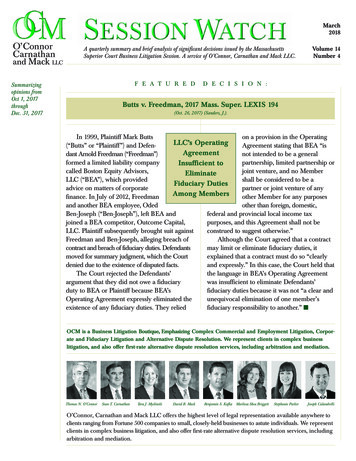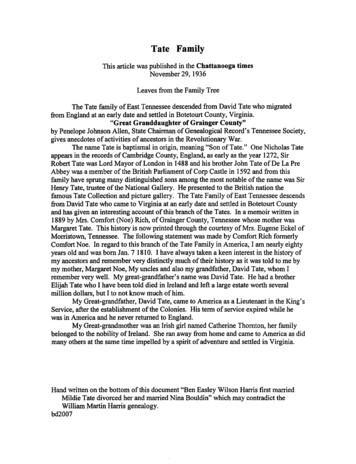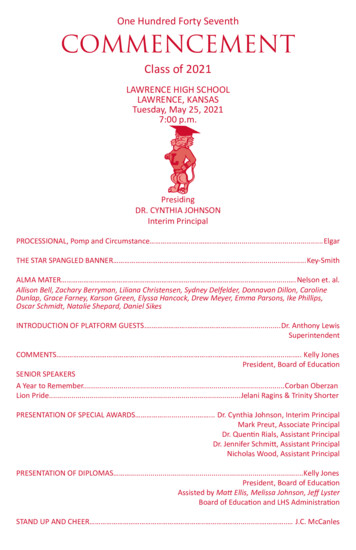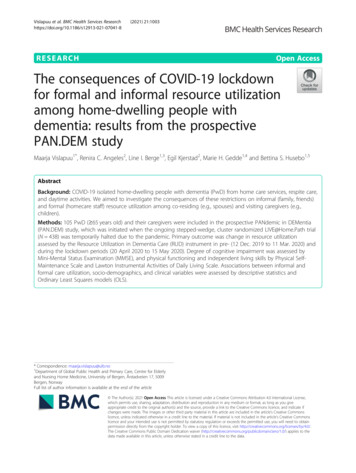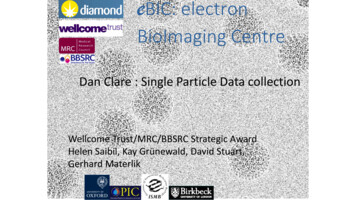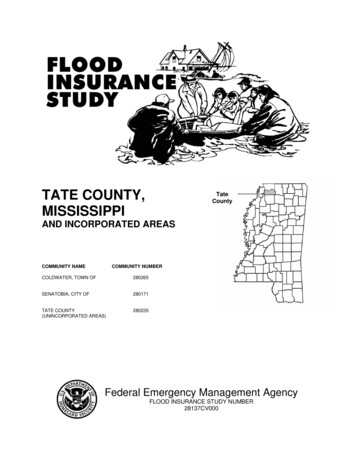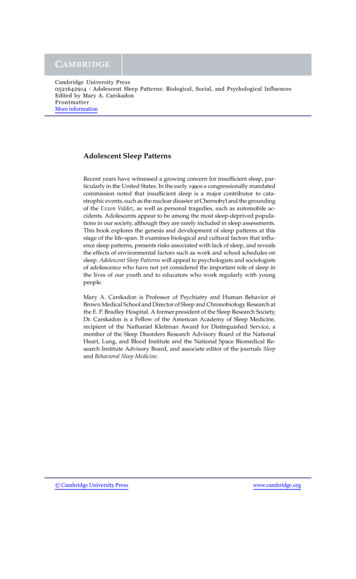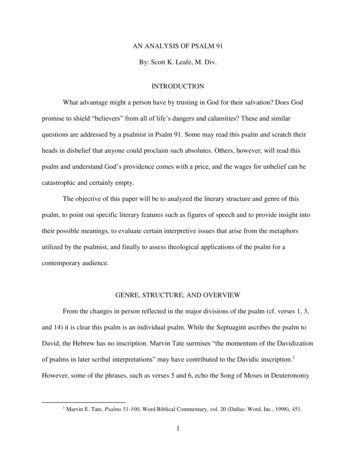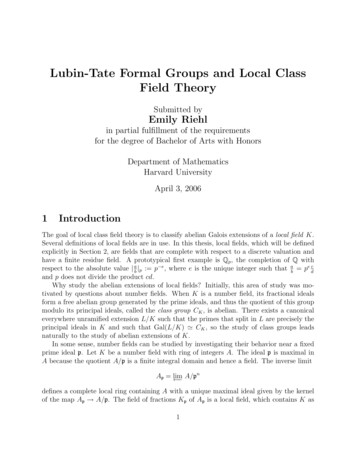
Transcription
Lubin-Tate Formal Groups and Local ClassField TheorySubmitted byEmily Riehlin partial fulfillment of the requirementsfor the degree of Bachelor of Arts with HonorsDepartment of MathematicsHarvard UniversityApril 3, 20061IntroductionThe goal of local class field theory is to classify abelian Galois extensions of a local field K.Several definitions of local fields are in use. In this thesis, local fields, which will be definedexplicitly in Section 2, are fields that are complete with respect to a discrete valuation andhave a finite residue field. A prototypical first example is Qp , the completion of Q withrespect to the absolute value ab p : p e , where e is the unique integer such that ab pe dcand p does not divide the product cd.Why study the abelian extensions of local fields? Initially, this area of study was motivated by questions about number fields. When K is a number field, its fractional idealsform a free abelian group generated by the prime ideals, and thus the quotient of this groupmodulo its principal ideals, called the class group CK , is abelian. There exists a canonicaleverywhere unramified extension L/K such that the primes that split in L are precisely theprincipal ideals in K and such that Gal(L/K) ' CK , so the study of class groups leadsnaturally to the study of abelian extensions of K.In some sense, number fields can be studied by investigating their behavior near a fixedprime ideal p. Let K be a number field with ring of integers A. The ideal p is maximal inA because the quotient A/p is a finite integral domain and hence a field. The inverse limitnAp lim A/pdefines a complete local ring containing A with a unique maximal ideal given by the kernelof the map Ap A/p. The field of fractions Kp of Ap is a local field, which contains K as1
a dense subfield. If the finite field A/p has characteristic p, then Kp is a finite extension ofQp . This construction can be repeated for all global fields, which include algebraic functionfields over a finite field as well as number fields, relating the study of local and global fields.At first, results in local class field theory were derived as a consequence of the global case,but it was soon discovered that local class theory can be constructed independently and infact provides tools that can be used to prove global theorems. Motivated by an analogy withthe theory of complex multiplication on elliptic curves, Lubin and Tate showed how formalgroups over local fields can be used to deduce several foundational theorems of local classfield theory, beginning by explicitly describing the maximal abelian extension K ab of a localfield K. Their 1965 paper [4] provides a particularly elegant and approachable foundationfor the subject by introducing formal power series that in some sense define a group lawwithout a group, which will be used to provide a set of elements that are adjoined to Kto produce certain abelian extensions with a natural module structure. Milne provides aconcise, detailed account on the connection to multiplication on elliptic curves (see [6, pg36-37]), though this is best read after one is familiar with the applications of the Lubin-Tateformal groups defined in Section 4.More specifically, it is often useful to decompose extensions of local fields into whatis called their ramified and unramified parts. When K is a local field and O its ring ofintegers, the ring O contains a unique maximal ideal m that is also its only prime ideal.In an unramified extension, this ideal remains prime, so unramified extensions occur inbijection with extensions of the residue field k O/m. It follows that these extensions canbe constructed canonically and that a maximal unramified extension K ur K ab exists. Theb the inverse limit of the cyclic groups Z/nZ forGalois group Gal(K ur /K) is isomorphic to Z,all positive n. Unramified extensions are discussed in greater detail in Section 2.2.By contrast, a maximal totally ramified extension, i.e., an extension in which the primeideal m of K ramifies as much as possible, does not exist canonically because the compositeof two totally ramified extensions is not always totally ramified. One of the first applicationsof Lubin-Tate formal groups is to construct a maximal totally ramified abelian extensionKπ K ab corresponding to each prime element π K ab . In Section 6.1, we will prove thatK ab Kπ · K ur ; hence, this construction provides the desired decomposition of K ab intounramified and totally ramified parts.Additionally, Lubin-Tate formal groups can be used to construct an injective homomorphism φ : K Gal(K ab /K) called the Artin map, named after a similar map firstconstructed in the global case by Emil Artin. The Artin map gives an isomorphism betweenthe subgroup Gal(K ab /K ur ) and O , the integral units of K. Combining this information,we get the following field diagram:K abEEb zzzZzzzzzEE O EEEEEEEEEEO EExxxxxxx bxx ZK urKπ EK2
b O . By choosing a prime element of K, we obtain anIn particular, Gal(K ab /K) ' Zb and φ maps π to an elementisomorphism K ' Z O . As K /O ' Z is dense in Zurb the image φ(K ) is dense in Gal(K ab /K).that generates this subgroup of Gal(K /K) ' Z,The Artin map satisfies further functorial properties as well. For example, this map factorsthrough quotients of the norm groups N (L ) of finite abelian extensions L/K to yield isomorphisms K /N (L ) Gal(L/K).With the Langlands program, work is now being done on non-abelian class field theory,although this is beyond the scope of this thesis.In Section 2, we will formally introduce local fields and their extensions and prove somepreliminary results. In Section 3, we will discuss formal group laws in general, and inSection 4, we will define Lubin-Tate formal groups. In Section 5, we will state a theoremcharacterizing the Artin map and begin its proof by constructing homomorphisms to theGalois groups of large abelian extensions of K. In Section 6, we will show that the abelianextensions that we have constructed are in fact the maximal abelian extension K ab , provethat the Artin map factors through quotients of finite norm groups, and conclude with asummary of these results. In Section 7, we provide an application of these results to theproblem of counting abelian extensions with certain Galois groups.The results in Sections 3, 4, and 5 have become fairly standard and were written inconsultation with Milne [6], Iwasawa [3], Serre in [1], and the original Lubin Tate [4]. Milne[6] and Serre [1] both give cohomological proofs of the existence of the Artin map, andthis result is assumed in Lubin Tate [4]. I will not assume that the local Artin map existsand will instead prove this in Section 6. Consequently, for this section as well as for thecharacterization of the norm groups of totally ramified extensions in Section 5, I will followIwasawa [3] instead. Section 7 represents my own work, in frequent consultation with FrankCalegari.In my work on this project, I am indebted to many people. First and foremost, I wouldlike to thank my thesis adviser Frank Calegari for help on all levels of this project, andparticularly for suggesting many exercises that have helped improve the depth of my understanding of this material. John Tate has also been very generous with his time, allowing meto discuss these topics with him, both in person and over e-mail. Greg Valiant read a draftand provided many helpful comments. I am also indebted to Dick Gross, who first suggestedthat I study Lubin-Tate formal groups, read a draft of this paper, and has been a mentor tome for the past several years. Finally, I would like to thank the Harvard Math Departmentfor challenging me and for making these past four years quite enjoyable.2PreliminariesLet K be a field. A discrete valuation on K is a function v : K R such that(a) v is a group homomorphism, i.e., v(xy) v(x) v(y) for all x, y K;(b) the image of v is a discrete subgroup of R;(c) v(x y) min(v(x), v(y))with the convention that v(0) . A discrete valuation defines a topology on K with3
respect to the metric x y c v(x y) for any constant c 1. The choice of c is unimportant, because the resulting topologies are equivalent. The map · : K R 0 is called amultiplicative valuation (to contrast with the additive discrete valuation defined above) andthe restriction to K gives a multiplicative homomorphism K R . By property (c), x y max( x , y ) for all x, y K; such valuations · are said to be non-archimedian.The ring of integers or valuation ring O of K is the set of elements with non-negativevaluation. More generally, the valuation ring is the set {x K : x 1}, a definition thatapplies to fields where only a multiplicative and not a discrete valuation is defined. The ringO has a unique maximal ideal m {x O : v(x) 0} {x O : x 1} because allelements x O with valuation 0 are units, i.e., m O O . Hence, O is a local ring.When v is normalized so that its image is equal to Z, an element π K such that v(π) 1is called an uniformizer or equivalently a prime element. For a fixed uniformizer π, everya K can be expressed uniquely in the form a uπ n where u O and n v(a) Z.It follows that O is a discrete valuation ring and its non-trivial ideals have the form π n O,n Z . The quotient k O/m is called the residue field of K.A field, which is complete with respect to the topology defined by a discrete valuation vand such that its residue field k is finite, is called a local field. A good first example is Qp , thecompletion of Q with respect to the p-adic metric, a localP fieldi with ring of integers Zp . Thering Zp can be thought of as the set of power series i 0 ai p with coefficients ai Z andp chosen as a natural uniformizer. Partial sums of these series form a sequence of rationalintegers that converge in the p-adic topology to an element of Zp . If the coefficients arerestricted to a lift of the residue field k ' Z/p, then these power series uniquely correspondPito elements of Zp . Similarly, elements of Qp uniquely correspond to Laurent series i n ai pwith ai {0, 1, . . . , p 1}.If the prime p is replaced with an indeterminate variable T , the resulting field is stilllocal. In fact, these examples completely characterize our definition of a local field, as seenin the following Theorem (for proof, see Serre [7, pg 33-40]).Theorem 2.1. Let K be a local field.(a) If K has characteristic 0, then K is isomorphic to a finite extension of Qpfor some prime p.(b) If K has characteristic p, then K is isomorphic to k((T )), the field of Laurent seriesover a finite field k of characteristic p.Throughout this thesis, let the residue field k be a field of order q and characteristic p.2.1Hensel’s Lemma and Teichmüller RepresentativesOne key tool in studying the algebra of local fields is Hensel’s Lemma, which gives a criterionfor when a polynomial has roots near a particular element of a local field K. There are manyversions of this result. This formulation and proof are taken from Cassels Fröhlich [1].Lemma 2.2 (Hensel’s Lemma). Let K be a local field and let f (X) O[X]. Let α0 O be4
such that f (α0 ) f 0 (α0 ) 2 . Then there exists α O such that f (α) 0 and α α0 f (α0 ).f 0 (α0 )Proof. We will define a Cauchy sequence α0 , α1 , α2 , . . . of approximate roots of f (X) thatconverges to a root α by an iterative procedure similar to Newton’s method. Define asequence of functions fi (X) O[X] by the algebraic identityf (X Y ) f (X) f1 (X)Y f2 (X)Y 2 · · ·over two independent variables. So f1 (X) f 0 (X). Define β0 by the equationf (α0 ) β0 f1 (α0 ) 0.Because fi (α0 ) O, fi (α0 ) 1, which means that f (α0 β0 ) max fi (α0 )β0i max β0 j i 2i 2 f (α0 ) 2 f (α0 ) . f1 (α0 ) 2Similarly, by expanding the polynomial f1 (X Y ), f1 (α0 β0 ) f1 (α0 ) f1 (α0 ) . Letα1 α0 β0 . It follows from these equations that(a) f (α1 ) f (α0 ) 2, f1 (α0 ) 2(b) f1 (α1 ) f1 (α0 ) ,(c) α1 α0 f (α0 ) . f1 (α0 ) By hypothesis, f (α0 ) f1 (α0 ) 2 , so (a) implies that f (α1 ) f (α0 ) , i.e., v(f (α1 )) v(f (α0 )). By repeating this process, we can construct a sequence α0 , α1 , α2 , . . ., where eachpair αn , αn 1 also satisfies (a), (b), and (c). Because v is discrete, v(f (αn 1 )) v(f (αn ))implies that f (αn ) approaches 0 as n gets large. Combining this fact with (b) and (c), wesee that the sequence α0 , α1 , α2 , . . . is Cauchy. Consequently, because K is complete, thereexists α limn αn in K, which has the desired properties. In fact, α is unique, becauseeach iteration of this procedure essentially computes α mod mn for increasing n.It is worth illustrating how Hensel’s Lemma may be applied. One example that highlightsthe analogy with Newton’s method in R is finding a square root α of 2 in Q7 , i.e., a root ofthe polynomial f (X) X 2 2. Take α0 3 because f (3) 0 mod 7, so v(f (α0 )) 1 andv(f 0 (α0 )) 0. Hence, v(f (α0 )) 2v(f 0 (α0 )), so f (α0 ) f 0 (α0 ) 2 and the hypothesis ofHensel’s Lemma are satisfied. The equation f (α0 ) β0 f1 (α0 ) 0 gives β0 7/6, whichis the 7-adic integer 7 72 73 · · · (for a leisurely introduction to p-adic arithmetic, seeGouvêa [2]). So α1 α0 β0 3 7 72 73 · · · which indicates that α 10 mod 72 .The next iteration of this process shows that α 108 mod 73 . Continuing in this manner,this process very slowly constructs α Q7 such that α2 2.Another useful construction is the Teichmüller representative, which provides an inverseof sorts to the map O k by associating each α k with a (q 1)-st root of unity a5
in O . The Teichmüller representatives are in bijection with the residue field and have thesame multiplicative structure. Given any lift a O of α k , definena : lim aq .n Because the residue field has q elements, aq a (mod m) for each a O by an analogue ofFermat’s Little Theorem. Furthermore, if a b (mod mn ), then aq bq (mod mn 1 ). Sonthe sequence, aq is clearly Cauchy, and hence completeness of local fields implies that itslimit is in O . The limit a clearly satisfies X q X, and so is in bijection with an element ofk , because a, and hence a, is non-zero. Of course, additively, elements of O behave quitedifferently from elements of k , but multiplicatively the bijection between a and its imagein the residue field is a homomorphism.Alternatively, Hensel’s Lemma can be used to prove the existence of Teichmüller representatives. Because the multiplicative group of the residue field k is cyclic of order q 1,the polynomial f (X) X q 1 1 splits modulo m into q 1 distinct linear factors. For anya O with valuation 0, a 6 0 mod m, so aq 1 1 0 mod m. However, the derivative(q 1)aq 2 6 0 mod m because both terms on the left hand side are units. In particular,v(f (a)) 1 0 2v(f 0 (a)), i.e., f (a) f 0 (a) 2 . By Hensel’s Lemma, there exists a(q 1)-st root of unity α such that α a m, and because we can choose a to be in eachof the q 1 distinct residue classes, there must q 1 distinct roots in K. In identifying arepresentative for a particular element of O , however, the construction via exponentiationis preferred to the more complicated construction given in the proof of Hensel’s Lemma.One important application of Teichmüller representatives is in the proof of the followinglemma.Lemma 2.3. Let K be a local field with integers O, maximal ideal m, and residue field k. Then O k (1 m).Proof. By the construction given above, the map a 7 a from a O to its Teichmüller representative in O is a multiplicative homomorphism. By construction, the set of Teichmüller representatives is isomorphic to k , and so a 7 a mod m, which we consider as an elementnof k . Because a limn aq , a a mod m, so in particular, a/a 1 m. Hence, themap a a mod m (a/a m) gives a homomorphism from O to k (1 m), which iseasily seen to be an isomorphism.2.2Extensions of Local FieldsAn algebraic extension E/K is separable if the minimal polynomial of every α E does nothave any multiple roots. An algebraic extension is normal if every irreducible polynomialover K with a root in E splits in E. When an extension is both normal and separable, foreach α E, the number of distinct automorphisms of K(α)/K equals the degree of thisextension, and E/K is said to be Galois. When a separable extension fails to be normal, itcan be embedded in its Galois closure by taking a splitting field. However, when an extensionfails to be separable, this presents a more serious problem, because there is no larger field6
in which an irreducible polynomial with multiple roots will yield the appropriate numberof distinct automorphisms. As a result, it is customary to assume separability from thebeginning; thus, requiring an extension E/K to be Galois simply amounts to replacing Ewith its Galois closure if necessary.When K has characteristic zero, then every algebraic extension is separable, and K iswhat is called a perfect field. When K has characteristic p, K may not be perfect, so theadditional hypothesis that extensions of K are separable will be required. Fix a separable,algebraic closure K s of K, which is equal to the algebraic closure K al in the case where Kis a perfect field. Throughout this thesis, “an extension of K” will mean “a subfield of K s .”In particular, all extensions will be assumed to be algebraic and separable.Let L be a finite extension of a local field K of degree n. If σ1 , . . . , σn denote the ndistinct embeddings of L into its Galois closure over K, then there exist homomorphismsTrL/K : L K and NL/K : L K defined byTrL/K (α) nXσi (α),NL/K (α) i 1nYσi (α)i 1called the trace map and norm map respectively. The norm map will prove particularlyimportant, and its image will be abbreviated by N (L ) whenever there can be no confusionabout the ground field K. This group will be characterized as a subgroup of K by Theorem6.9.The valuations v and · can be extended uniquely to L by the formulas (see [5, pg105-106]):q1 α L n NL/K (α) .vL (α) v(NL/K (α)),nIn particular, field automorphisms preserve v and · . Note that if α K , then NL/K (α) αn , so vL v on K and likewise for · L . It will most often be convenient to normalize vso that v(π) 1 for primes π K even though the image of vL may not be contained in Z.Infinite extensions of local fields are not themselves local, yet a localS ring and maximalSideal can nonetheless be defined. If [E : K] is infinite, define OE OL and mE mLwhere the unions are taken over all K L E such that L/K is finite. Because v and · extend uniquely to each finite L/K, they also extend to E, although v may no longer bediscrete. As in the finite case, Os {α K s α 1} and ms {α K s α 1}, givingfurther justification to these names.For any Galois extension E/K, which may or may not be infinite, define a topology onGal(E/K) where the setsGal(E/L), E L K, [L : K] form a fundamental system of neighborhoods of the identity. It follows that two elements ofGal(E/K) are “close” if they agree on a large subfield of E that is finite over K. If E/K isfinite, then Gal(E/E) {1} is open and the topology on Gal(E/K) is discrete. If E/K isinfinite, then this is not the case.7
It follows fromQ this definition that Gal(E/K) is compact. To see this, consider the mapGal(E/K) Gal(L/K) where each component is the canonical projection map σ 7 σ Land the product is taken over all L E that are finite and Galois over K. Because E isthe union of finite Galois extensions, the map is injective. The topology described above isinduced on Gal(E/K) via this map by endowing each Gal(L/K) with the discrete topologyand the product with the product topology. Any closed subset of this productis compact, soQto show that Gal(E/K) is compact it suffices to show that its image in Gal(L/K) is closed.For every point (. . . , σL , . . .) not in the image, thereQ must be some components σL0 and σL00such that L0 L00 and QσL00 L0 6 σL0 . Let U L6 L0 ,L00 Gal(L/K) {σL0 } {σL00 }. ThenU is an open subset of Gal(L/K) that separates this point from the image of Gal(E/K).So the image of Gal(E/K) in this product is closed, and therefore, Gal(E/K) is compact.Local class field theory studies the abelian extensions of a local field. The composite oftwo abelian extensions is again abelian because the group Gal(L1 · L2 /K) is a subgroup ofthe product Gal(L1 /K) Gal(L2 /K) via the homomorphism σ 7 (σ L1 , σ L2 ). Hence, itmakes sense to define a maximal abelian extension K ab of K as the composite of all finiteones.One natural way to describe an abelian extension L/K is to separate it into a tower of itsunramified and totally ramified parts. As a consequence of Lemma 2.4 below, L contains acanonical unramified extension F of K obtained by adjoining the Teichmüller representativesof the residue field kL to K. The extension L/F will be totally ramified. By contrast, nocanonical totally ramified subextension of L exists, a fact that will motivate the constructionof Kπ in Section 5.There are many equivalent definitions of when an extension is ramified. In the localcontext, an extension L/K is unramified if a prime element π of K remains prime in L,i.e., if every α L can be written as uπ n for some u OL and n Z. The extensionis ramified otherwise. For finite extensions, the ramification degree of L/K is the uniquepositive integer e such that the image of the extension of the normalized valuation v of K toL is 1e Z. A prime element of K would have valuation 1, while a prime element of L wouldhave valuation 1e . Note that if e 1, then prime elements of K are prime in L and theextension is unramified. If e [L : K] then L/K is totally ramified. Equivalently, it followsfrom the definition of vL that L/K is totally ramified if and only if N (L ) contains a primeof K. If p does not divide e then the extension is tamely ramified, and it is wildly ramifiedotherwise.2.2.1Unramified ExtensionsUnramified extensions are characterized through the following important lemma.Lemma 2.4. Let L/K be a finite, Galois extension. If L/K is unramified, then there is a canonical isomorphism Gal(L/K) Gal(kL /k) where kL is the residue field of L.Conversely, if Gal(L/K) ' Gal(kL /k), the L/K is unramified.Proof. Let L/K be finite and Galois, let kL k[a], and let g(X) be the minimal polynomialfor a. Because k is finite, it is perfect, and g(X) has distinct roots. If g(X) is any lift of8
g(X) to L, then by Hensel’s Lemma there exists a unique α L such that g(α) 0 andα a mod m. Because L is Galois, g splits in L, so g splits in kL , and kL /k is Galois.Automorphisms of L/K preserve OL and mL , so there is a well-defined homomorphismGal(L/K) Gal(kL /k). When L/K is unramified, [L : K] [OL : O] [OL /(π) : O/(π)] [kL : k], so L K(α) and each σ Gal(L/K) maps α to a distinct conjugate. Theconjugates of α are distinct in kL , because finite fields are perfect, which means that g isseparable. Thus, by Hensel’s Lemma, the map Gal(L/K) Gal(kL /k) is surjective, andtherefore an isomorphism.Conversely, if Gal(L/K) ' Gal(kL /k), then [OL /mL : O/m] [kL : k] [L : K] [OL /O] [OL /(π) : O/(π)]. As OL has only one ideal of each index, this implies thatmL (π). In particular, π remains prime in L, so L/K is unramified.The composite of two unramified extensions is again unramified, so it makes sense to define a maximal unramified extension K ur of K as the union of all finite unramified extensions.One natural question is whether K ur K ab . This is true, and follows as a consequence ofthe following lemma.Lemma 2.5. For any local field K and positive integer n, there exists a unique unramifiedextension L of degree n over K, which is Galois with cyclic Galois group.Proof. It is well known that the elements of the finite field k of order q are precisely theroots of X q X in the separable closure of Z/p. Furthermore, there exists a unique cyclicnextension of degree n over k consisting of the roots of X q X. Let g(X) be the minimalpolynomial for a primitive (q n 1)-st root of unity over k and let g(X) be any lift of g(X)to K. Then g is irreducible because it is irreducible mod m. Let L be the splitting field ofg over K. By the theory of Teichmüller representatives, the roots of g in L are in bijectionwith the roots over k, so they are distinct. Hence, L/K is separable and Galois, and becausethe degree of g is equal to the degree of g, [L : K] [Fqn : k] n. Let kL be the residue fieldof L. By construction, kL Fqn , so [kL : k] n. But [L : K] is always greater than or equalto [kL : k], so kL Fqn . Because Gal(L/K) maps onto Gal(kL /k) and these groups havethe same order, they are isomorphic, so from Lemma 2.4, L/K is an unramified extensionof degree n, as desired. In particular, Gal(L/K) ' Gal(kL /k), which is cyclic because kL /kis a finite Galois extension of finite fields.For uniqueness, assume two distinct unramified extensions L, L0 existed. Then the composite extension LL0 would also be unramified over K. By the above observation that theGalois groups of L/K and L0 /K are both Z/n, and the Galois group of LL0 /K must bea finite cyclic group as well. Let E L L0 , also an unramified extension of K of ordern/m. Then Gal(L/E) ' Gal(L0 /E) Z/m, because this extension is unramified. BecauseL L0 E, Gal(LL0 /E) ' Z/m Z/m, which is not cyclic, contradicting the fact that thisextension is unramified. This contradiction guarantees uniqueness.Not only is Gal(L/K) cyclic when L/K is unramified, but it has a canonical generator.Let r [kL : k], where k is a finite field of order q pf . Then the map Frob(x) xqis an automorphism of kL /k called the Frobenius automorphism. Because kL has order q r ,9
rFrobr (x) xq x for all x kL so Frob has order dividing r. If Frobd were the identitydfor some d r, then the elements of kL would all be roots of X q X, which cannot bebecause q d #kL . So Frob has order r and thus generates Gal(kL /k). By the isomorphism,for unramified extensions there is a unique automorphism σ Gal(L/K) such that σx xq(mod π) for all x L and that generates Gal(L/K). This automorphism is denoted byFrobL/K .It follows from Lemma 2.5 that K ur Kn where Kn denotes the unique unramifiedextension of K of degree n. By the theory of Teichmüller representatives, Kn is in fact thensplitting field of X q X over K. Furthermore, the Frobenius automorphism extends to K urand can be identified as the image of the generators of Gal(Kn /K) Z/n inb lim Z/nZ.Gal(K ur /K) Z 2.2.2Ramified ExtensionsIn general, ramified extensions are more complicated than their unramified counterparts. Tostudy these extensions, it is useful to keep more precise track of the behavior of elements ofits Galois group. For any Galois extension L/K, there exist subgroupsIn {σ Gal(L/K) v(x σx) n 1 x L}called higher ramification groups for each n N. The higher ramification groups clearlyform a chain of decreasing subgroups Gal(L/K) I0 I1 · · · . The group I0 is the inertiagroup I that arises as the kernel of the exact sequence0 I Gal(L/K) Gal(kL /k) 0because σ I0 if and only if σ acts trivially on the residue field.When L/K is unramified, Gal(L/K) ' Gal(kL /k) by Lemma 2.4, so the inertia group istrivial. Conversely, if the inertia group is trivial, then Gal(L/K) ' Gal(kL /k), which impliesthat L/K is unramified. In general, Gal(L/K)/I0 ' Gal(kL /k) is the Galois group of thelargest unramified subextension of L/K.When L/K is totally ramified, the index [mL : m] n, which means that [kL : k] [OL /mL : O/m] [L : K]/[mL : m] n/n 1. So kL k and Gal(kL /k) is trivial, whichmeans that I0 Gal(L/K). In this case, the higher ramification groups can be identified bycomputing v(π σπ) for a fixed prime π L, a fact that is proven in the following lemma.Lemma 2.6. Let L/K be totally ramified and let π L be any prime element. Then thegroup In {σ Gal(L/K) v(π σπ) n 1}.Proof. If σ In , then from the original definition, it is clear that v(π σπ) n 1. To showconversely that if v(π σπ) n 1 then σ In , it suffices to show that v(π σπ) v(x σx)for all x L.Let a1 , . . . , aq L denote any lift of the residue field kL such that the ai are distinctmodulo mL . Then any x L can be written uniquely as b n π n · · · b0 b1 π · · ·10
where the coefficients bi are in the set {a1 , . . . , aq }. Choose the set {a1 , . . . , aq } to be theTeichmüller representatives in L. Then the ai are fixed by Gal(L/K) I0 . So given x Land σ Gal(L/K), x σx b1 (π σπ) b2 (π 2 (σπ)2 ) · · · , because the terms of valuationless than one must vanish because Gal(L/K) I0 . This expression can be factored to yieldx σx (π σπ)(b1 b2 (π σπ) · · · ). As x σx is the product of π σπ and an integer,it follows that v(π σπ) v(x σx), completing this proof.The following lemma will prove useful later on.Lemma 2.7. Let L/K be a finite Galois extension of local fields. Then if the residue fieldof L has order q 0 , [I0 : I1 ] (q 0 1) and [In : In 1 ] q 0 for n 1. Furthermore, for largeenough m, In {1} for all n m, so I1 has p-power order.Proof. For the first claim, we will prove something slightly stronger: namely, that there isa homomorphism I0 OL /(1 mL ) with kernel I1 given by σ 7 σπ/π where π is a fixedprime in L. To see this, note that σπ and π have the same valuation, so this element isindeed a unit. For σ, τ I0 , τ (σπ/π) σπ/π mod mL , so τ σπ/(τ π) σπ/π and henceτ σπ/π (τ π/π)(σπ/π) mod mL . In particular, this map is a homomorphism, as claimed.If σ I1 , then σπ π mod m2L , which by div
of Lubin-Tate formal groups is to construct a maximal totally rami ed abelian extension K ˇˆKab corresponding to each prime element ˇ2Kab. In Section 6.1, we will prove that Kab K ˇKur; hence, this construction provides the desired decomposition of Kab into unrami ed and totally rami ed parts.
